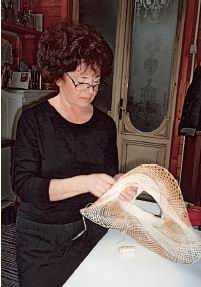An interview with Silvia Fedorová
Editorial board
Silvia Fedorová, the textile artist, established her own gallery 15 years ago. She cooperates with young artists and designers and seeks opportunities for them to display their work, present and exhibit it, make contacts, and she also creates exhibitions and organizes them. After the Czechoslovakia state split up, the Bavarian Art and Craft Chamber asked her for cooperation in organizing a selective exhibition and competition entitled Talents held in Munich. Previously, the selection of Slovak artists had been organized out of Prague. Since 1993 more than 30 young artists have presented their work in Munich. “One of the goals we established when we started the gallery was to allow talented students and graduates to exhibit their work. I also realize the complexity of the environment into which they enter after finishing school, so I am happy to exchange my long-term experiences with them. Cooperation with young authors comes naturally to me, and I have been devoting my time to it throughout my entire professional career.”
“If one of my goals is that many artists will stay creating textiles, I have to try to make their journey to professional practice a bit easier. For example, by inviting them to exhibitions that are organized by our textile group, exhibiting graduate works in our gallery, or alerting them to the possibility of exhibiting their work abroad. One of the opportunities where I see young textile designers able to find their place is to establish small workshops oriented on producing a variety of goods currently lacking in the marketplace. It is difficult to start alone as an artist, but small groups have a greater chance. Unfortunately, school does not provide sufficient know-how for students. During their studies they develop their creative, conceptual thinking but lack contact with the real world and experience of practical life around and the links among individual sectors. It is more often only by coincidence that a textile designer cooperates with a clothes or furniture designer.”
Currently it is a slow time in exhibition activities in the field of utilitarian art. There are several reasons for this: insufficient financial resources as well as exhibition areas, an unreliable grant system for supporting the arts, or even a lack of good management… Therefore it must be mentioned that the tradition of a biennale of utilitarian art exhibitions ceased in the 1990s.
“Interrupted tradition is hard to be renewed. I am sure that regular exhibitions would be a significant stimulation for this area of creation… I am also wondering whether there is a demand for the art. But there is no demand unless there is production.”
The cycle of supply and demand does not have a beginning – the wider the selection of quality art production and its accessibility in galleries, the more this will influence the aesthetic criteria at exhibitions. The interest of the general public also inspires creation and is a motivational factor for various activities. What possibilities exist to start this relationship – the creator and the general public? “Exhibition and presentational possibilities – more galleries and exhibitions, more significant and variable events… The general public is interested in how these items are created and when they come to a working studio they understand it better. I have a personal experience that when I was creating bobbin lace directly at the exhibition, people were more interested. People need to know how things are created. That’s how the aesthetic feeling is cultivated.”
